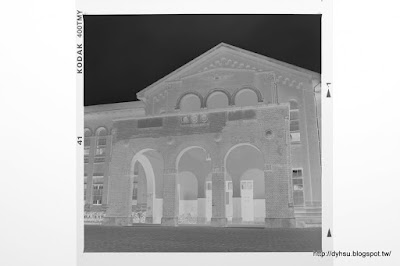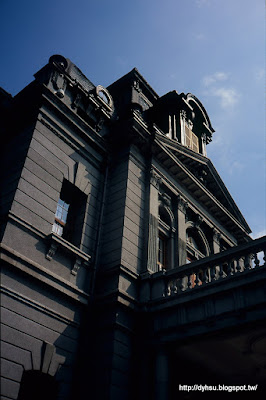The rainy weather was not suitable for shooting color film, so I took a roll of 120 black and white negative film and a camera and walked to the National Taiwan University campus to shoot historical buildings (note 1). Because of the rainy day, the sky was almost white, and the buildings themselves were very dark due to insufficient light. The result of trying to make the buildings themselves normally exposed was that the sky was obviously overexposed. Perhaps the effect of underexposing 1 f-stop would be better.
Note 1: National Taiwan University Library was founded as the Taihoku Imperial University Library in March 1928 by the Japanese colonial government.
其他照片請參閱 相簿-台大圖書館舊館。
陰雨綿綿的天氣實在不適合拍正片,索性拿了捲120黑白負片與相機,走路到台大校園拍攝古蹟建築。因為陰雨天的關係,天空近乎白色,而建物本身則因光線不足而顯得非常昏暗,盡量讓建物本身正常曝光的結果,天空部分明顯地曝光過度,或許再少曝光1 f-stop的效果會比較好吧。
使用器材:

Yashica MAT 124 G is a reasonably priced camera with good optical and mechanical quality. I first got it in 1997, but then sold it to raise money for a Hasselblad. Last year (2007), I decided to buy another Yashica MAT 124 G from an online auction to relive the experience of shooting 120 black and white film.
YASHICA MAT 124 G 是一台價格合理,光學與機械品質均佳的相機。第一次入手約昰1997年,後來因為籌錢買哈蘇,就賣掉了。去年(2007),因為想再來回味120的黑白底片,所以又從網路上標購了一台品相尚佳的 YASHICA MAT 124 G。
This time, I decided to digitize the black and white negatives instead of printing them as usual. The tools I used are as follows:
使用器材:

Yashica MAT 124 G is a reasonably priced camera with good optical and mechanical quality. I first got it in 1997, but then sold it to raise money for a Hasselblad. Last year (2007), I decided to buy another Yashica MAT 124 G from an online auction to relive the experience of shooting 120 black and white film.
YASHICA MAT 124 G 是一台價格合理,光學與機械品質均佳的相機。第一次入手約昰1997年,後來因為籌錢買哈蘇,就賣掉了。去年(2007),因為想再來回味120的黑白底片,所以又從網路上標購了一台品相尚佳的 YASHICA MAT 124 G。
This time, I decided to digitize the black and white negatives instead of printing them as usual. The tools I used are as follows:
這次拍攝120黑白負片,除了沖片以外,並未如往常的習慣去印樣。而是將它數位化,我準備的工具如下:
- Canon EOS Kiss DIgital N
- Contax Makor-Planar 100/2.8
- Standard color temperature light box 標準色溫燈箱
- A piece of non-reflective transparent glass 不反光透明玻璃一片
- Adobe PhotoShop
看到這裡聰明的網友,應該會會心一笑,原來我昰利用數位單眼相機直接將黑白底片數位化,再用PhotoShop 將負片轉為正相,之後的濃淡與對比的調教全都以數位暗房來達成。

Photo 1: Old Library, NTU 台灣大學圖書館舊館 (Yashica MAT 124G, Yashinon 80/3.5)

Photo 2: An 120 B&W film digitalized by Canon EOS Kiss Digital N 拍攝120黑白負片
Other photos can be found in the Old Library, NTU album.

Photo 1: Old Library, NTU 台灣大學圖書館舊館 (Yashica MAT 124G, Yashinon 80/3.5)

Photo 2: An 120 B&W film digitalized by Canon EOS Kiss Digital N 拍攝120黑白負片
Other photos can be found in the Old Library, NTU album.
其他照片請參閱 相簿-台大圖書館舊館。

















